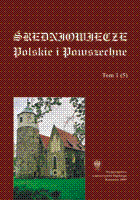Kontakty Olafa Tryggvasona z Jomsborgiem - pomiędzy legendą a historyczną rzeczywistością
Olaf Tryggvason's contacts with Jomsborg - between a legend and a historical reality
Author(s): Jakub MorawiecSubject(s): History
Published by: Wydawnictwo Uniwersytetu Śląskiego
Summary/Abstract: The king of Norway is one of the most popular figures praised by a Middle-Aged Scandinavian historiography. He was commemorated by not only the contemporary scalds (above all Hallfred Ottarson), but also occupied an important place in royal sagas created starting from the turn of the 12th and 13th century, the four of which were specially devoted to his life and reign. Olaf Tryggvason was remembered above all as a ruler - missionary who devoted his life to propagating Christianity in Norway, in Island and islands of the North Atlantic. The very events made the king of Norway a legend consisting of many threads though often of little credibility or simply fantastic motives. It also concerns the period of Olaf's youth which he, according to an almost unanimous opinion of sag authors, was supposed to spend in Rusia and subsequently, orgainizing plundering excursions in the Baltic Sea. It was in this very period of time that Olaf Tryggvason was to appear in Vindland (the land of Slavs), notably in Jomsborg, where Geira, a daughter of Buryslaw, reigned. The king of Norway to be was to attract Geira and married her soon. Co-rulling with her in Vindland he turned out to be an outstanding ruler and warrior and was respected among his subjects. However, when Geira died three years later, Olaf Tryggvason, in deep grief, despite the subjects' requests, decided to leave Vindland he was supposed to go back to, as the tradition says, just before his death. The very legend, first extended by Oddr Snorrason and later on running through other narrations (above all "Heimskringla, Olafs saga Tryggvasonar en mesta") was the source of interests of the researchers interested in the explanation of the credibility of information on the "slavic episode" in Olaf Tryggvason's life. It is easy to distinguish three tendencies here. The advocates of the first one fully believed in the message from sagas. The representatives of the second totally rejected it, treating it as a pure fiction. My article is an attempt to incribe into and develop the third tendency. The aim of my considerations is not to arbitrarily decide on the credibility or its lack of the messages in question, but wonder why the ones responsible for writing down the tradition functioning so far in the oral form, decided to create the legend in that, not the other way, by means of developing one and avoiding other motives the king of Norway was associated with. (...)
Journal: Średniowiecze Polskie i Powszechne
- Issue Year: 2009
- Issue No: 5
- Page Range: 19-42
- Page Count: 24
- Language: Polish

